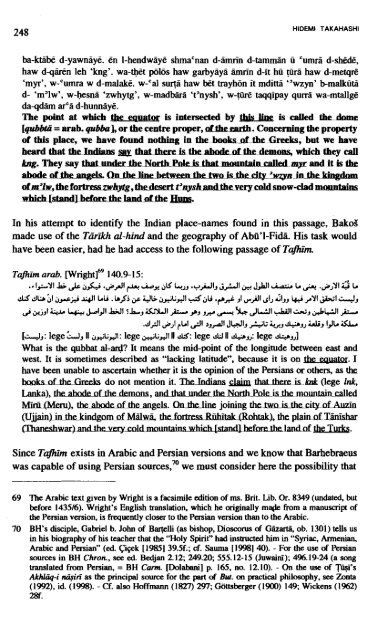doc.pdf
doc.pdf
doc.pdf
You also want an ePaper? Increase the reach of your titles
YUMPU automatically turns print PDFs into web optimized ePapers that Google loves.
a-kt& d-yawnaye. En 1-hendwayE shmacnan d-hrin d-tamman u 'urnrii d-shEdE,<br />
haw dqMn leh kg'. wa-t&t pdos haw garbyaya m-n d-it hu @ra haw d-met@<br />
'my', w-'umra w d-malake. w-'a1 sum haw Mt trayhon it mdittii '"wzyn' b-malkutil<br />
d- 'm31w', w-hesni 'zwhytg', w-madb*a 't3nysh', w-guE taqqipay qurri wa-mtallge<br />
daqd&n arCa d-hunnaye.<br />
The point at which the eauata is intersected by this is called thuhw<br />
---- 3<br />
of m'lw.,<br />
[qubM = arab. qubba], or the centre proper, d. Concerning the property<br />
of this place, we have found nothing in -Gm&s, but we have<br />
heard that tbe a &aUkxthatfhereis- which they call<br />
bg. They say - Poleism and it is the<br />
thdesxt- very mld snow-clad<br />
IYJlkhlstsndl-m.<br />
In his attempt to identify the Indian place-names found in this passage. BakoS<br />
made use of the Tirikh al-hind and the geography of AbB'1-Fidi. His task would<br />
have been easier, had he had access to the following passage of Tmrn<br />
Tajhim arab. wrightf9 140.9- 15:<br />
--<br />
.I<br />
.al+Yl & j&i &&,all r+ Li.p* j(l lYJJ a"AIJ a J&l h C. .sJYI itj C.<br />
&S Sb 31 j+> 41 C.1, . bJi dl; j&J +A jli 8 1 . ~ 2 ,I dlJ Ll,, ,YI 4,<br />
j *LJ~ &A 4 &IJ M I LL, &Wl ;-..-- 9, ,+ & J U I +bill ;.;J &L=JI ;-..--<br />
.dAl &JI rC.1 j" ~~,.dl JWI, ,&.G LM d+JJ irlij IJC. i S L<br />
14,: lege ll &L,Jl: lege II a: lege &I II QU: lege eJJ]<br />
What is the w-? It means the mid-point of the longitude between east and<br />
west. It is sometimes described as "lacking latitude", because it is on the. I<br />
have been unable to ascertain whether it is the opinion of the Persians or others, as the<br />
do not mention it. The Tndians ht&xekhk (lege Ink,<br />
Lanka), ~ f andthatunder the Niddkkisthemddled ~ ,<br />
- -<br />
m s . On joining the_rJara&hesiQdAwh<br />
- -<br />
(Ujai-ndgamof thdh-<br />
the plain& Dnidu<br />
t h e v e r p ~ 1 a n U<br />
m.<br />
Since Tafiim exists in Arabic and Persian versions and we know that Barhebraeus<br />
was capable of using Persian sources,70 we must consider here the possibility that<br />
69 The Arabic text given by Wright is a facsimile edition of ms. Brit. Lib. Or. 8349 (undated, but<br />
before 143516). Wright's English translation, which he originally ma& from a manuscript of<br />
the Persian version, is frequently closer to the Persian version than to the Arabic.<br />
70 BH's disciple, Gabriel b. John of Baelli (as bishop, Dioscorus of Gbarti4, ob. 1301) tells us<br />
in his biography of his teacher that the "Holy Spirit" had instructed him in "Syriac. Armenian,<br />
Arabic and Persian" (ed. Ci~k [1985] 39.5f.3 cf. Sauma [I=] 40). - For the use of Persian<br />
sources in BH Chron., see ed. Bedjan 2.12; 249.20; 555.12-15 (Juwaini); 4%.19-24 (a song<br />
translated from Persian, = BH Cam. [Dolabani] p. 165, no. 12.10). - On the use of 'j'i&i's<br />
AkMq-i win as the principal source for the part of But. on practical philosophy, see Zonta<br />
(1992). id. (1998). - Cf. also Hoffmann (1827) 297, Gottsberger (1900) 149; Wickens (1%2)<br />
28f.
















